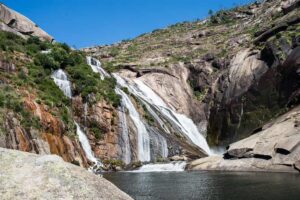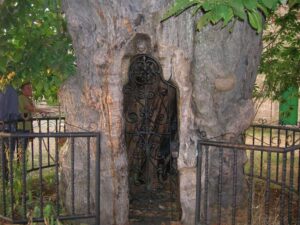
More and more hiking enthusiasts, before setting off to walk the Camino de Santiago, are looking for routes that allow them to test their endurance. The Caminito del Rey, in Málaga, has become one of the favourite options for those who want to experience something intense, short but unforgettable, before embarking on a multi-day journey.
With its walkways suspended over 100 metres above the Guadalhorce River and its rugged landscape of vertical cliffs, this route offers a perfect balance between physical challenge and natural beauty.
Índice de contenidos
- 1 What is the Caminito del Rey and why does it captivate hikers?
- 2 Practical information for walking the Caminito del Rey
- 3 The Caminito del Rey as training for the Camino de Santiago
- 4 Why this is an excellent test before the Camino
- 5 Other tips for hikers wanting to take the leap to the Camino de Santiago
What is the Caminito del Rey and why does it captivate hikers?
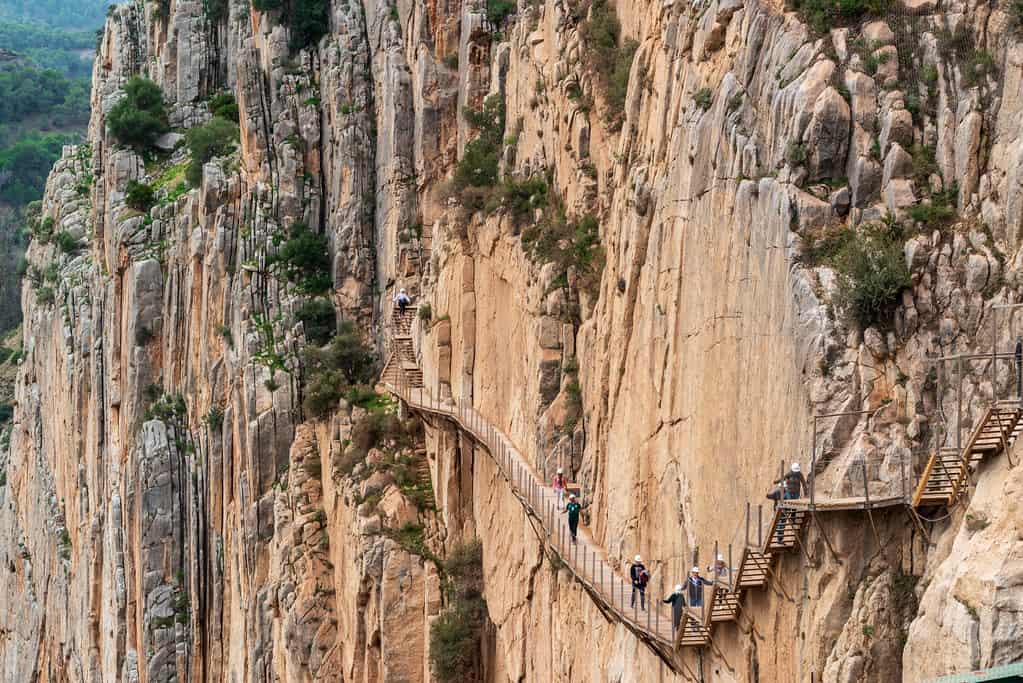
The Caminito del Rey is one of the most spectacular —and photographed— routes in Spain.
Its history dates back to the early 20th century, when it was built as access for the workers responsible for the maintenance of the hydraulic channels between the El Chorro and Gaitanejo reservoirs. The walkway, anchored to the cliffs of the Gaitanes Gorge, facilitated transit between the dams in a rough and inaccessible area.
It is named after King Alfonso XIII, who in 1921 walked part of the route to inaugurate the Conde de Guadalhorce dam. Since then, the walkway went from being a functional structure to becoming a myth among mountain lovers. However, after decades of neglect, the original path fell into ruin and became sadly famous for its danger.
Everything changed in 2015, when it was completely restored with modern safety measures, preserving its original layout but making it an accessible and regulated path.
Practical information for walking the Caminito del Rey
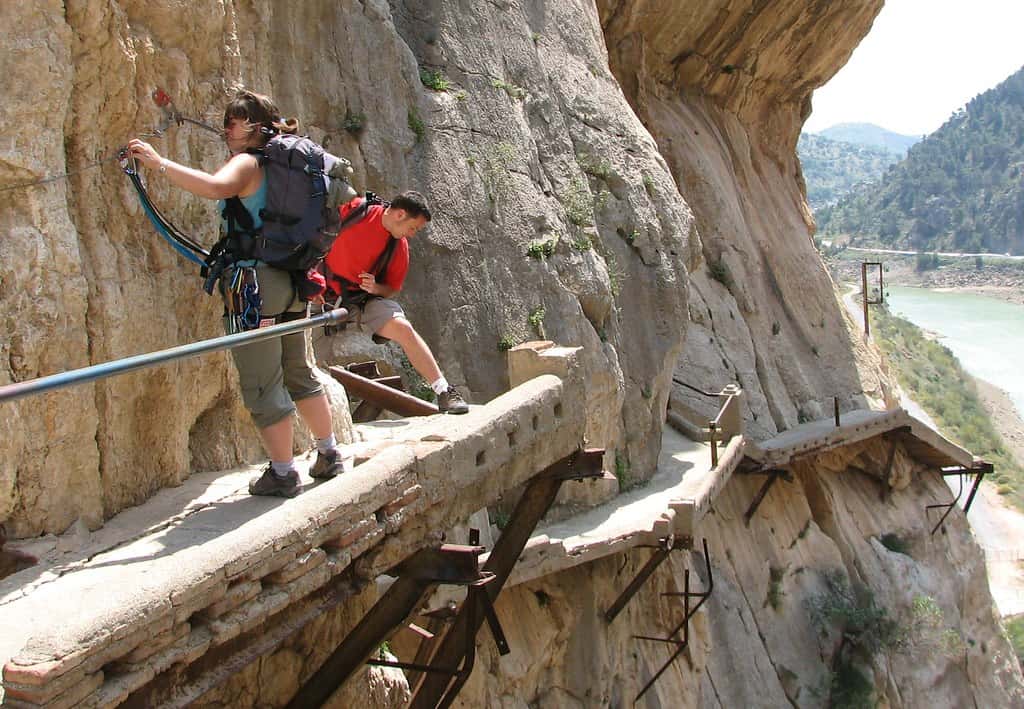
Difficulty and Duration
Although its fame might be intimidating, the Caminito del Rey is now a safe and accessible route for most people with average fitness. The total distance is around 7.7 kilometres, with only 2.9 km corresponding to the section of hanging walkways. The rest consists of natural trails and paths crossing the gorge’s surroundings.
The usual duration of the route is between 3 and 4 hours, depending on the pace and the number of stops. There are no steep inclines or technically difficult areas, but there are long stretches without shade or places to rest. For this reason, it’s advisable to allow enough time and avoid the hottest hours, especially in summer.
As for the level of difficulty, it could be considered medium-low. It’s an excellent option for those who want to challenge themselves before embarking on longer routes like the Camino de Santiago.
Is the Caminito del Rey dangerous?
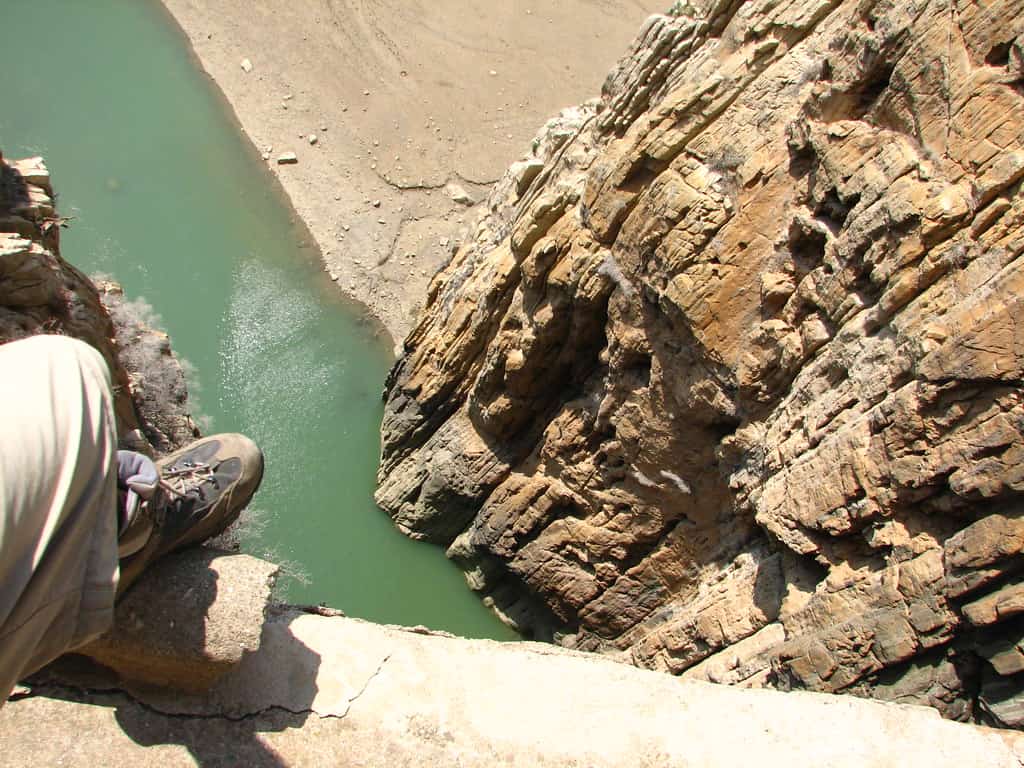
This is a common question, and the answer depends more on the visitor’s perception than the current reality.
After its restoration, it is a completely safe route, with reinforced walkways, steel handrails, and mandatory helmets provided at the entrance. However, the route is not suitable for people with vertigo or a fear of heights, as much of the journey is suspended in mid-air, offering spectacular… and sometimes intimidating views.
Weather conditions can affect access, especially in cases of heavy rain or strong winds, as the route is temporarily closed for safety reasons. Therefore, it is advisable to check the weather forecast before the visit and to be flexible with your dates, if possible.
Tips for enjoying the experience
To make the most of this unique route, here are some practical tips to keep in mind:
- Book in advance: access is regulated and limited. It is mandatory to buy tickets online and select a specific entry time.
- Choose your gear carefully: comfortable footwear is recommended, preferably hiking boots or shoes with good soles. Walking sticks, large backpacks, and umbrellas are not allowed.
- Protect yourself from the sun: much of the route has no shade. Bring a cap, sunglasses, and sunscreen, especially if you are going during the hot months.
- Stay hydrated and bring light food: there are no fountains or picnic areas along the route, so it’s important to carry a bottle of water (at least 1 litre) and some energy food.
- Arrive early: the access is through the municipality of Ardales and ends at El Chorro. There is a shuttle bus service connecting both points, but it’s important to plan your travel time properly.
The Caminito del Rey as training for the Camino de Santiago
Similarities: nature, physical effort, and emotional reward
For many hiking lovers, the Caminito del Rey is not only an adventure in itself. More than that, it is an excellent mental and physical preparation for more extensive challenges, like the different routes of the Camino de Santiago.
Although the duration may not be comparable, both experiences share key elements: contact with nature, the need to maintain focus, and a deep sense of personal achievement.
For example, those who have walked the Camino de Santiago from Bilbao to Santander know that its early stages offer coastal stretches, intense climbs, and spectacular landscapes that require some prior preparation. The Caminito, although brief, can be a good gauge to see how the body responds to elevation changes, heat, and some exposure to the environment.
Similarly, the Camino del Norte from Ribadeo shares with this route that fusion of natural beauty and physical intensity. The cliffs of the Cantabrian coast, the humidity of the environment, and the continuous ascents echo the challenge of walking on suspended walkways, where every step demands presence and focus.
In any case, the connection with the landscape is complete. Whether observing birds of prey flying over the Málaga gorge or contemplating the Asturian cliffs, the hiker is immersed in the surroundings.
Differences: duration, logistics, and continuity of effort
Despite the similarities in terms of the environment and emotional experience, the differences between both are substantial.
- The Caminito is a one-off activity, half a day, with a clearly defined start and finish. It does not require carrying luggage or planning where to sleep or what to eat the next day.
- In contrast, the Camino is a prolonged experience. It involves walking several consecutive days and managing aspects such as daily physical recovery, personal pace, changing weather, and interaction with other walkers. It is a more introspective experience, requiring progressive endurance and constant adaptation.
The Caminito can serve as a symbolic “stage zero”: a way to familiarise oneself with extended walking, prior preparation, and the sense of achievement. But it does not replace the experience of walking every day at your own pace.
Why this is an excellent test before the Camino
Ideal for those wanting to measure their preparation
Walking the Caminito del Rey is a practical way to assess whether you have the right preparation to take on the challenge of walking for several days along variable paths. Although the distance is much shorter, walking for several hours on uneven terrain, with heat, elevation changes, and no option to quit halfway through the route is very revealing.
It also allows you to check how your body responds to the prolonged use of technical footwear, how to manage walking pace, or the small obstacles on the path (blisters, thirst, fatigue, etc.). For those who have not yet embarked on a multi-day journey, it can serve as a first “intermediate” experience between a simple walk and a long-distance route.
Mental and physical training before several days of walking
Beyond the physical aspect, walking on suspended walkways, with the abyss beneath your feet, is a test of serenity, self-control, and focus.
Although the route is completely secure, it forces the walker to stay alert, trust their body, and manage their emotions. This is especially useful if you plan to undertake a pilgrimage route, where not only physical effort counts, but also the ability to adapt to the unexpected.
A perfect example to begin with could be the Camino Portugués from Tui, one of the most accessible and pleasant stretches to get started. With an approximate duration of one week and stages of moderate difficulty, it offers a balanced experience of landscape beauty, history, and Jacobean tradition.
And the best part: after completing the Caminito, many pilgrims find they are more prepared than they thought.
Other tips for hikers wanting to take the leap to the Camino de Santiago
From one-off experience to initiation journey
For many hikers, the step from the Caminito del Rey to a Camino de Santiago route is not just a matter of distance or duration: it’s an evolution in the way of travelling.
Making that leap doesn’t mean just setting out to walk hundreds of kilometres, but adapting the challenge to your personal moment. What matters is not the length of the journey, but the willingness to walk each day with purpose, enjoying what the path offers: from rural landscapes to conversations with fellow pilgrims.
If you feel ready for that step, there are many accessible options to get started, and you don’t have to organise everything on your own. There are specialised agencies offering Camino de Santiago trips that provide advice, route ideas, and proposals suited to all levels.
Which Camino to choose to start
In addition to the already mentioned Camino Portugués from Tui, there are other ideal routes to start on the right foot, such as the Camino Francés from Sarria or the Camino Inglés from Ferrol. What’s important is to begin with enthusiasm, knowing that it’s not a race, but a journey experienced step by step.

